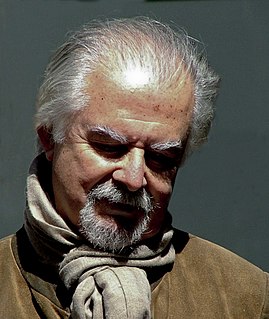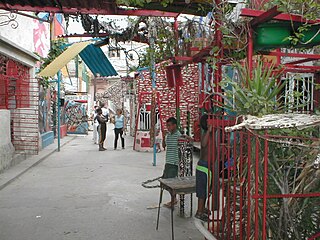
Fernando Botero Angulo is a Colombian figurative artist and sculptor, born in Medellín. His signature style, also known as "Boterismo", depicts people and figures in large, exaggerated volume, which can represent political criticism or humor, depending on the piece. He is considered the most recognized and quoted living artist from Latin America, and his art can be found in highly visible places around the world, such as Park Avenue in New York City and the Champs-Élysées in Paris.

Miguel Ortiz Berrocal was a Spanish figurative and abstract sculptor. He is best known for his puzzle sculptures, which can be disassembled into many abstract pieces. These works are also known for the miniature artworks and jewelry incorporated into or concealed within them, and the fact that some of the sculptures can be reassembled or reconfigured into different arrangements. Berrocal's sculptures span a wide range of physical sizes from monumental outdoor public works, to intricate puzzle sculptures small enough to be worn as pendants, bracelets, or other body ornamentation.

Ángel Botello was a Spanish-Puerto Rican painter, sculptor and graphic artist. He was dubbed "The Caribbean Gauguin" for his use of bold colors and depictions of island life. Botello is considered one of the greatest Latin American post-modern artists and recognition and demand for his artwork continues to grow today, fetching unprecedented auction prices.

Antoni Tàpies i Puig, 1st Marquess of Tàpies was a Catalan Spanish painter, sculptor and art theorist, who became one of the most famous European artists of his generation.

Alejandro Jesús Obregón Rosės was a Colombian painter, muralist, sculptor and engraver.

Cuban art is an exceptionally diverse cultural blend of African, South American, European, and North American elements, reflecting the diverse demographic makeup of the island. Cuban artists embraced European modernism, and the early part of the 20th century saw a growth in Cuban avant-garde movements, which were characterized by the mixing of modern artistic genres. Some of the more celebrated 20th-century Cuban artists include Amelia Peláez (1896–1968), best known for a series of mural projects, and painter Wifredo Lam, who created a highly personal version of modern primitivism. The Cuban-born painter Federico Beltran Masses (1885–1949), was renowned as a colorist whose seductive portrayals of women sometimes made overt references to the tropical settings of his childhood.

Débora Arango Pérez was a Colombian artist, born in Medellín, Colombia as the daughter of Castor María Arango Díaz and Elvira Pérez. Though she was primarily a painter, Arango also worked in other media, such as ceramics and graphic art. Throughout her career, Arango used her artwork to explore many politically charged and controversial issues, her subjects ranging from nude women to the role of the Roman Catholic Church to dictatorships.
Latin American art is the combined artistic expression of South America, Central America, the Caribbean, and Mexico, as well as Latin Americans living in other regions.

Juan Mario de la Espriella Salcedo better known as Juancho de la Espriella Salcedo is a Colombian musician interpreter of vallenato in accordion. De la Espriella is the current accordionist of Colombian vallenato singer Mono Zabaleta.

Colombian art has 3500 years of history and covers a wide range of media and styles ranging from Spanish Baroque devotional painting to Quimbaya gold craftwork to the "lyrical americanism" of painter Alejandro Obregón (1920–1992). Perhaps the most internationally acclaimed Colombian artist is painter and sculptor Fernando Botero (1932).
Feliciano Béjar Ruíz was a Mexican artist and artisan, best known for a style of sculpture called "magiscopios" which involved various materials along with crystals and/or lenses to play with light or create distorted visions. He was born in rural central Mexico and was completely self-taught as an artist. He was creative as a young child, drawing and creating his first sculpture like pieces from papier-mâché. His art career began in New York, where he had travelled and lived for a time in Hell's Kitchen. His drawing the attention of Arthur Ewart and Frances Coleman, with the latter helping him have his first exhibition and whose husband helped sponsor his time in Europe. The magiscopes arose from an intense interest in light and the sun, which began when he saw a boy in Italy playing with reflections of the sun in puddles. Images of the sun appeared in his painting and sculpture, developing into the use of crystals and lenses. In his later life, Béjar withdrew from the art world for about sixteen years, disillusioned with it and retreating to his ranch in the State of Mexico. He returned in 1998, with a retrospective of his work in Mexico City and continued to show his work until shortly before his death.

Milton Becerra is a Venezuelan artist who pioneered land art in Venezuela in the 1970s.
Miguel Hernández Urbán is a Mexican painter and sculptor noted for his monumental works in stainless steel. He trained as a sculptor at the Escuela Nacional de Artes Plásticas but moved into painting under Antonio Rodríguez Luna. He returned to sculpture in the 1980s, experimenting with stainless steel, creating monumental works with it starting in the 1990s. In 1992, he founded the Symposium on Stainless Steel Sculpture in his hometown, the first of its kind in the work, which has since attracted participants from the Americas, Europe and Asia.
Francisco Icaza was a Mexican artist best known for his drawings about his travels and his oil paintings. He spent much of his life living in and visiting various countries around the world. He began painting as a child while living as a refugee in the Mexican embassy in Germany. Icaza exhibited his work both in Mexico and abroad in Europe, South America, the Middle East, Asia and India, most notably at his three major solo exhibitions at the Museo de Arte Moderno in Mexico City. He also painted a mural dedicated to Bertolt Brecht, La Farándula, at the Casino de la Selva in Cuernavaca, a focus of controversy when the work was moved and restored in the early 2000s. He painted additional murals for the Mexican Pavilion at the HemisFair in Texas ; for the Mexican Pavilion at Expo 67 in Montreal, Canada ; and for the Mexican Pavilion in Osaka at Expo '70. This last mural is held at the Museo de Arte Abstracto Manuel Felguérez in Zacatecas City. He was an active member of the Salón de la Plástica Mexicana and also a member and founder of several important Mexican artistic movements including Los Interioristas, El Salón Independiente, and La Confrontación 66.
Miguel Ángel Martín Bordera is a Spanish artist born in Alicante in Spain on 24th September 1966. He is the founder and current director of the street theater company named Carros de foc.

Jorge Rando is a Spanish painter and sculptor, considered one of the most recognised artist of the Neo-expressionist art movement. A world class study of key figures of Expressionism and Neo-expressionism, from the Museum of Modern Art in Salzburg, identified Rando as one of the best advocates of neo-expressionism in the world. The expert study selected Rando and Miguel Barceló as the only two representatives of this artistic movement in Spain. Therefore, in recognition of Rando's fruitful artistic career, the first Expressionist museum in Spain, inaugurated in Málaga in 2014, bears his name Museum Jorge Rando. Currently, the painter lives and works between Málaga, Spain and Hamburg, Germany.

Indochristian art, is a type of Latin American art that combines European colonial influences with Indigenous artistic styles and traditions.

Jesus de Miguel is a prominent: Spanish artist, closer to the neo expressionist style born in Palencia, Spain.

Farid Mansour (1929–2010) was a Lebanese sculptor and painter.
"NOBLE". (2000). FAMA.














